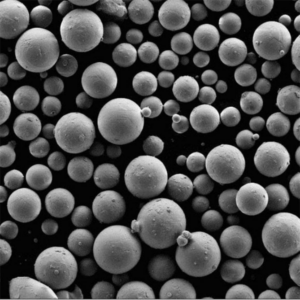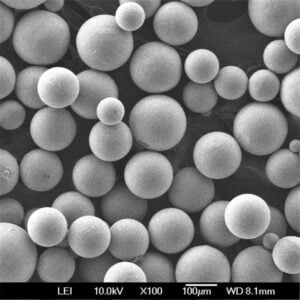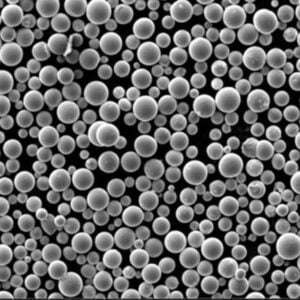
NiTi50 Powder: The Ultimate Guide for 2025
Low MOQ
Provide low minimum order quantity to meet different needs.
OEM & ODM
Provide customized products and design services to meet unique customer needs.
Adequate Stock
Ensure fast order processing and provide reliable and efficient service.
Customer Satisfaction
Provide high quality products with customer satisfaction at the core.
share this article
Table of Contents
Overview
NiTi50 powder, also known as Nickel-Titanium Shape Memory Alloy (SMA) powder, contains 50% nickel and 50% titanium. It is widely recognized for its shape memory effect, superelasticity, and biocompatibility, making it an indispensable material in aerospace, medical, automotive, and additive manufacturing (3D printing) applications.
Key Properties
✔ Shape memory effect, allowing the material to return to its original shape after deformation
✔ Superelasticity, providing excellent flexibility and fatigue resistance
✔ Biocompatibility, making it ideal for medical implants and surgical instruments
✔ Corrosion resistance, suitable for harsh environments and medical applications
✔ Optimized for additive manufacturing (AM), metal injection molding (MIM), and thermal spray coatings
This guide will explore:
- Best NiTi50 powder for 3D printing
- How to choose the right NiTi50 powder
- Top suppliers of NiTi50 powder
- Properties and industrial applications
- Production methods and cost analysis
- Comparing gas-atomized vs. plasma-atomized NiTi50 powder
Best NiTi50 Powder for 3D Printing in 2025
Why NiTi50 Powder is Ideal for Additive Manufacturing?
- Excellent shape memory properties, making it perfect for medical and aerospace applications
- Superior fatigue resistance, ensuring long-term structural integrity
- High corrosion resistance, preventing degradation in biological and industrial environments
- Excellent printability, reducing defects in metal 3D printing
Key Factors for Selecting NiTi50 Powder for 3D Printing
- Spherical morphology for optimal powder flowability
- Controlled particle size distribution enhances printability and layer adhesion
- Low oxygen & impurity levels prevent oxidation defects
- Consistent mechanical properties post-processing
Comparison for Different 3D Printing Technologies
| 3D Printing Technology | Recommended NiTi50 Powder | Advantages | Challenges |
|---|---|---|---|
| Laser Powder Bed Fusion (LPBF) | Gas-atomized spherical powder (15-45µm) | High precision, fine details | Requires optimized laser parameters |
| Electron Beam Melting (EBM) | Gas-atomized powder (45-105µm) | Low residual stress | Limited material availability |
| Direct Energy Deposition (DED) | Gas-atomized powder (50-150µm) | Large-scale part production | Requires post-processing |
| Binder Jetting | Irregular or spherical powder (30-80µm) | High-speed production | Requires sintering & infiltration |
For high-performance 3D printing applications, Met3DP’s gas-atomized NiTi50 powder is the preferred choice. Learn more about Met3DP’s high-quality metal powders.
How to Choose the Right NiTi50 Powder
Choosing the right NiTi50 powder depends on factors such as particle size distribution, atomization process, and specific application requirements.
1. Particle Size Distribution (PSD)
- Fine powders (15-45µm) → Best for LPBF (Laser Powder Bed Fusion)
- Medium powders (45-105µm) → Suitable for EBM & Binder Jetting
- Coarse powders (50-150µm) → Used in DED (Direct Energy Deposition)
2. Powder Morphology
- Spherical Powder → Best for 3D printing and powder bed fusion technologies
- Irregular Powder → Suitable for Binder Jetting & Sintering
3. Atomization Process
- Gas-Atomized Powder → High purity, excellent flowability, best for 3D printing
- Plasma-Atomized Powder → Ultra-high purity, best for medical and aerospace applications
Comparison of Different Types
| Factor | Gas Atomized | Plasma Atomized |
|---|---|---|
| Sphericity | High | Very High |
| Purity | High | Ultra-High |
| Flowability | Excellent | Outstanding |
| Cost | Medium | High |
| Best for | 3D Printing, Aerospace | Medical Implants, High-Performance AM |
For high-precision 3D printing, Met3DP’s gas-atomized NiTi50 powder is the best choice. Contact Met3DP for more details.
Top Suppliers in 2025
Several manufacturers produce high-quality NiTi50 powder, but not all powders meet stringent additive manufacturing requirements.
Leading Suppliers and Their Offerings
| Supplier | Location | Powder Type | Specialization |
|---|---|---|---|
| Met3DP | China | Gas-atomized NiTi50 | High-performance AM powders |
| Höganäs | Sweden | Plasma-atomized | Medical & Aerospace Applications |
| Carpenter Additive | USA | Gas-atomized | Medical & Defense |
| Sandvik | Sweden | Gas-atomized | Industrial & Aerospace Applications |
| AMETEK | USA | Plasma-atomized | High-purity Medical Applications |
Among these, Met3DP stands out due to its cutting-edge atomization technology and consistent powder quality. Explore Met3DP’s NiTi50 product range.
Production Methods
The production method of NiTi50 powder plays a crucial role in determining its particle shape, purity, flowability, and overall performance. Given the stringent requirements for medical, aerospace, and high-tech applications, selecting the right production technique is critical.
Comparison of Production Methods
| Production Method | Particle Shape | Purity | Best Applications | Cost |
|---|---|---|---|---|
| Gas Atomization (GA) | Spherical | High | 3D Printing, Medical, Aerospace | Medium |
| Plasma Atomization (PA) | Highly Spherical | Very High | High-End AM, Medical Implants | High |
| Mechanical Milling (MM) | Irregular | Moderate | Powder Metallurgy, MIM | Low |
1. Gas Atomization (GA)
Process:
- NiTi50 alloy is melted and atomized using high-pressure inert gas (argon or nitrogen), rapidly cooling the droplets into fine, spherical particles.
Advantages:
✔ High sphericity, improving powder flowability and printability
✔ Low oxygen content, preventing oxidation defects
✔ Excellent particle uniformity, ensuring consistent layer deposition in AM
Best for: Laser Powder Bed Fusion (LPBF), Electron Beam Melting (EBM), and Direct Energy Deposition (DED)
2. Plasma Atomization (PA)
Process:
- NiTi50 wire is fed into a high-energy plasma arc, melting it into fine droplets that form highly spherical powder particles.
Advantages:
✔ Perfect spherical shape, ensuring superior flowability
✔ Ultra-high purity, making it ideal for medical implants & aerospace components
✔ Minimal satellite particles, leading to superior print quality
Disadvantages:
✖ Higher production costs
✖ Limited scalability for large-scale production
Best for: Biomedical applications, high-performance 3D printing, and aerospace components
3. Mechanical Milling (MM)
Process:
- NiTi50 alloy ingots are mechanically milled into fine powder under controlled conditions.
Advantages:
✔ Lower production cost compared to gas-atomized and plasma-atomized powder
✔ Higher surface area, improving sintering behavior
Disadvantages:
✖ Poor flowability, making it unsuitable for powder bed fusion processes
✖ Higher oxygen content, requiring additional post-processing
Best for: Metal Injection Molding (MIM) and Powder Metallurgy
For high-quality 3D printing, Met3DP’s gas-atomized NiTi50 powder is the best choice. Explore Met3DP’s powder production solutions.
Cost Analysis in 2025
The price of NiTi50 powder depends significantly on its production method, particle morphology, purity level, and application-specific requirements.
Factors Affecting Cost
- Production Method – Plasma-atomized powders are the most expensive, while mechanically milled powders are more affordable.
- Particle Shape – Spherical powders (for AM) are more expensive than irregular powders.
- Purity Level – Higher purity = Higher cost.
- Market Demand – Increased demand from medical, aerospace, and robotics industries influences pricing.
Estimated Price Ranges
| Powder Type | Price (USD/kg) | Best For |
|---|---|---|
| Gas-Atomized NiTi50 Powder | 250−250 – 250−400 | 3D Printing, Medical, Aerospace |
| Plasma-Atomized NiTi50 Powder | 500−500 – 500−800 | High-End Medical Implants |
| Mechanically Milled NiTi50 Powder | 150−150 – 150−250 | MIM, Powder Metallurgy |
For cost-effective, Met3DP provides precision-engineered solutions tailored to industrial needs. Contact Met3DP for pricing and availability.
Gas Atomized vs. Plasma Atomized vs. Mechanical Milled: Which is Better?
Choosing the right NiTi50 powder depends on your application requirements.
Comparison of Different Types
| Feature | Gas Atomized | Plasma Atomized | Mechanical Milled |
|---|---|---|---|
| Particle Shape | Spherical | Highly Spherical | Irregular |
| Flowability | Excellent | Outstanding | Poor |
| Purity | High | Very High | Medium |
| Cost | Medium | High | Low |
| Best For | 3D Printing, Aerospace | Medical Implants | Powder Metallurgy |
For medical implants and aerospace applications, plasma-atomized NiTi50 powder is the best choice. For cost-effective 3D printing, gas-atomized NiTi50 powder provides the best balance of quality and cost.
FAQ
Q1: What is the best NiTi50 powder for 3D printing?
Gas-atomized spherical NiTi50 powder is optimal for LPBF, EBM, and DED due to its excellent flowability and low oxygen content.
Q2: How does NiTi50 compare to other shape memory alloys?
NiTi50 offers higher shape memory properties and superelasticity compared to other nickel-titanium alloys, making it ideal for medical implants and aerospace applications.
Q3: Can NiTi50 be used for metal injection molding (MIM)?
Yes, mechanically milled NiTi50 powder is commonly used in MIM and high-precision applications.
Q4: Where can I buy high-quality NiTi50 powder?
Met3DP is a leading supplier of gas-atomized NiTi50 powder, optimized for 3D printing and high-performance applications. Contact Met3DP today!
Conclusion
It is an excellent high-performance alloy for medical implants, aerospace, robotics, and additive manufacturing industries. Choosing the right powder type, production method, and supplier ensures optimal performance and reliability.
Why Choose Met3DP’s NiTi50 Powder?
✅ Industry-leading gas atomization technology
✅ High-purity spherical powders for additive manufacturing
✅ Reliable supply chain & global distribution
For high-performance NiTi50 powder, Met3DP provides state-of-the-art solutions tailored to industrial demands.
Want to learn more or get a quote? Contact Met3DP today!
Get Latest Price
About Met3DP
Product Category
HOT SALE
CONTACT US
Any questions? Send us message now! We’ll serve your request with a whole team after receiving your message.

Metal Powders for 3D Printing and Additive Manufacturing
COMPANY
PRODUCT
cONTACT INFO
- Qingdao City, Shandong, China
- [email protected]
- [email protected]
- +86 19116340731








